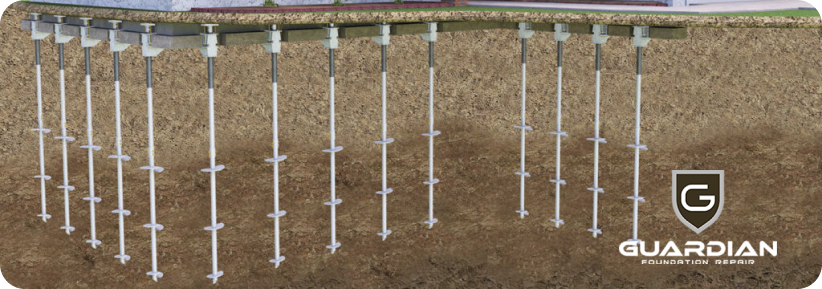Introduction
For homeowners in Knoxville, few concerns are as unsettling as the prospect of foundation damage. Although the main foundation typically receives the most attention, it’s crucial not to neglect your garage.
Just like any other part of your home, this structure requires regular maintenance and care and can suffer from typical building issues such as leaking roofs, uneven floors, and settling foundations. Depending on its location and whether it’s attached to your home, these issues can greatly affect your home’s overall safety and value.
In this blog post, we’ll delve into everything you need to know about garage foundation repair in Knoxville. We’ll specifically address the two most common issues: sinking or cracking floors and settling foundations.
How to Spot Foundation Issues in Your Garage
Ensuring your garage’s foundation is sound is key to avoiding bigger issues down the road. Here are some straightforward signs that might indicate there’s a problem:
- Cracks Are Showing: If you see cracks in the garage’s walls, floors, or ceiling, it’s time to take note. These cracks might be straight, diagonal, or appear in clusters.
- Unlevel Floors: Garage floors that dip or slope can be a big clue that the foundation beneath is moving. This can also cause water to collect, which might lead to more damage.
- Doors and Windows Stick: If your garage doors or windows don’t open or close smoothly, the foundation could have shifted.
- Gaps at the Ceiling: Any gaps between the walls and the ceiling suggest the foundation may be settling unevenly.
- Stair-Like Cracks on the Exterior: Noticeable stair-step cracks in brick or concrete are a classic sign of foundation issues.
Keeping an eye out for these signs can help you catch foundation problems early. If you spot any of these issues, getting in touch with a foundation contractor is a smart move. Quick action can prevent further damage and keep your garage safe and sound.
Understanding What Leads to Garage Foundation Problems
The stability of your garage largely depends on its foundation, which in turn relies on the soil beneath it. One of the primary reasons for garage foundation troubles is what foundation repair experts call differential settlement. This occurs when the soil under different parts of the foundation shifts unevenly.
Initially, it’s normal for a new foundation to settle a bit uniformly as it adjusts to the weight it supports. This is typically not a cause for concern.
However, differential settlement is different and far more problematic. It causes parts of the foundation to move at different rates, leading to potential structural damage throughout your garage.
The impact of differential settlement can be significant, affecting everything from the alignment of the structure to its overall safety. Since the repercussions of ignoring such issues can be extensive and expensive, addressing foundation problems promptly is essential.
Worried about the cracks in your garage?
Reach out to Guardian Foundation Repair to see if your garage foundation needs repair.
How Garage Foundation Repair is Carried Out
Before discussing the specifics of garage foundation repairs, it’s important to recognize that this is not a do-it-yourself endeavor. Due to the complexities and potential hazards involved, enlisting the help of a professional foundation repair contractor is essential.
Fixing a foundation requires precision and expertise because mistakes can lead to significant risks, not just to the structure but also to personal safety. A qualified team brings the necessary skills and equipment to ensure the repair is done correctly and safely.
Repairing a Settled Garage Foundation with Slab Jacking
Settling is a natural occurrence for all structures, including garages. Over time, various factors such as changes in weather, variations in moisture, and even different loads can affect the soil beneath a garage.
For instance, switching from a lightweight vehicle to a heavier one can increase the stress on an already burdened foundation.
A common and efficient method to correct a sinking garage foundation is slab jacking. This technique involves raising a sunken concrete slab to its original level without breaking, removing, or replacing the existing concrete. Slabjacking is cost-effective and time-efficient, making it an excellent choice for foundation repairs.
The slab jacking process works by injecting a robust filler material beneath the slab, like a cement mix or a modern polymer resin (e.g., Uretek or polyurethane foam). This injection helps lift the concrete back to its proper alignment and seals any gaps or separations caused by the settling. This method restores the foundation and strengthens it against future settling.
Repairing a Sinking Garage Slab with Push Piers
When a garage foundation begins to show signs of significant cracking and settling, one effective solution is the installation of push piers. This method, also known as underpinning, is highly regarded for its ability to level foundations and enhance stability, reducing the likelihood of future settlement.
The Process of Installing Push Piers:
- Initial Preparation: The first step involves exposing the foundation’s footer and ensuring there is a clearance of about two feet from the footer’s bottom to the excavation site’s bottom. This space is critical for the installation of equipment.
- Setting the Base: A 12-inch-long, 6-inch-diameter concrete cylinder is positioned in the hole. This cylinder serves as the primary support structure for the push pier system.
- Driving the Cylinders: The cylinder is driven into the soil using a powered ram topped with a titanium plate to brace the footer. This step is crucial for establishing the base of the push pier.
- Reinforcement: #4 rebar is fed through a 1/2-inch hole in the cylinder to enhance its stability. Additional cylinders are then driven into place sequentially. This process continues, building pressure incrementally until the foundation wall is sufficiently stabilized or lifted.
- Final Adjustments: Once the cylinders are securely placed, an 8x8x16 inch, 9000 psi cap block is fixed to the top of the pier. Adjustments are made using a 20-ton bottle jack to ensure the foundation is perfectly level.
- Finishing Touches: The final step involves shimming the gap between the cap block and the footer with cylinders. The excavation is then backfilled, and the soil is tamped down to ensure tight compaction and stability.
The advantage of using push piers is that this method is minimally invasive, requiring only handheld equipment and minimal space. This makes it an excellent choice for foundation repair in constrained areas. The precision of this process ensures that the garage slab is not only corrected but also fortified against future issues.
Preventive Measures for Garage Foundation Problems
Maintaining the integrity of your garage’s foundation doesn’t just involve repairs—it’s also about taking proactive steps to prevent issues from arising. Here are several effective strategies to help protect your garage’s foundation:
- Regrade the Surrounding Landscape: Ensure that the terrain around your garage slopes away from the structure. This grading prevents groundwater from accumulating near the foundation, crucial in avoiding water damage.
- Extend Downspouts: Downspouts are essential for directing rainwater away from your garage. If they’re too short, water may pool around the foundation, leading to erosion and structural issues over time. Installing downspout extensions is a simple and cost-effective way to ensure water is discharged further away, minimizing the risk.
- Maintain Clean Gutters: Regularly cleaning your gutters removes leaves and debris, ensuring water can flow freely. This prevents overflow and buildup around the foundation, which could otherwise lead to water intrusion and foundation weakening.
- Install a Drain Tile System: To combat moisture buildup around your garage’s foundation, consider installing a drain tile system. This involves placing a perforated pipe around the perimeter of the foundation at the footing level, which collects and redirects excess water to a sump pit. When the pit fills, a sump pump activates to pump the water away from the foundation, thereby mitigating moisture-related issues.
- Manage Tree Planting: Be mindful of tree planting near your garage. The roots of large trees can extend far beneath the surface, potentially disrupting the soil and foundation stability. Keeping trees at a safe distance from your garage helps to avoid these underground conflicts.
Secure Expert Garage Foundation Repair in Tennessee
The importance of engaging a seasoned professional for your garage foundation repair cannot be emphasized enough. An expert team can thoroughly assess the causes of your foundation issues and provide customized solutions that stand the test of time.
If you’re in Knoxville, TN, or the surrounding areas and facing foundation problems, Guardian Foundation Repair is your go-to expert. Specializing in foundation repair Tennessee, we offer comprehensive services to address and resolve your foundation concerns.
Reach out today to explore how we can assist you with your foundation needs.

